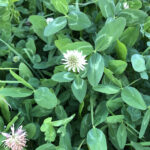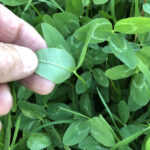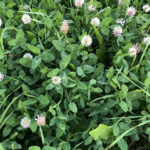Kura Clover
Trifolium ambiguum
General Description
Kura clover is a less commonly known perennial legume adapted to the cool moist soils found in the Black, Dark Grey and Grey soils. For the first 2-3 years after seeding, kura clover focuses on developing a massive root system which limits the above ground production and competitiveness. During this time, it is at great risk of being outcompeted by companion species. Once roots are well established, above ground productivity and competitiveness aggressively increase. Kura clover is noted for very early spring growth, high production, longevity, winter hardiness, and drought tolerance under grazing systems. Its resilience is due to deep crowns, a taproot extending over 1 meter into the soil, and strongly spreading rhizomes.
Kura clover forms a canopy of stems, petioles and leaves as it grows that sit about 30 cm (12 in) tall. Stems may reach 50 cm (20 in) tall. Leaves are three hairless leaflets attached to the hairless stem. Kura clover grows a high quantity of petioles and leaf matter in relation to stems, with leaflets up to 8cm (3 in) long and 5 cm (2 in) wide. The leaflets are very oblong with rounded narrow tips and have a strongly visible V watermark on them. Flowers are a characteristic clover shape and start off white changing to pink as the season progresses. Very few flowers and seeds are produced by kura clover, severely limiting commercial use and availability.
Kura clover is a less commonly known perennial legume adapted to cool moist soils. For the first 2-3 years after seeding, kura clover focuses on developing a massive root system which limits the above ground production and competitiveness. During this time, it is at great risk of being outcompeted by companion species. Once roots are well established, above ground productivity and competitiveness aggressively increase. Kura clover is noted for very early spring growth, high production, longevity, winter hardiness, and drought tolerance under grazing systems. Its resilience is due to deep crowns, a taproot extending over 1 meter into the soil, and strongly spreading rhizomes.
Kura clover forms a canopy of stems, petioles and leaves as it grows that sit about 30 cm (12 in) tall. Stems may reach 50 cm (20 in) tall. Leaves are three hairless leaflets attached to the hairless stem. Kura clover grows a high quantity of petioles and leaf matter in relation to stems, with leaflets up to 8cm (3 in) long and 5 cm (2 in) wide. The leaflets are very oblong with rounded narrow tips and have a strongly visible V watermark on them. Flowers are a characteristic clover shape and start off white changing to pink as the season progresses. Very few flowers and seeds are produced by kura clover, severely limiting commercial use and availability.
Type
Tame legume.
Origin
South-eastern Europe (Caucasus Mountain region).
Longevity
At least 10 years. While it is a lesser used species in Canada, known stands have persisted thus far.
Use
Pasture, stockpiled. Ideal for close rotational grazing systems, intensive grazers like sheep but should be managed for adequate rest and recovery for highest productivity.
Pasture, stockpiled. Ideal for close rotational grazing systems including intensive grazers like sheep but should be managed for adequate rest and recovery for highest productivity.
Optimal Time of Use
Spring, summer, fall, winter. Kura clover is a versatile species. Time grazing to begin once the full canopy develops. Once established, kura clover is very tolerant of close, frequent grazing and high animal traffic (advantage of rhizomes). Maximum yields can be obtained with rotational grazing. Winter use is possible due to deep crowns, rhizomes, and average leaf retention.
Recovery After Use
Requires 30-45 days for recovery. This varies based on moisture, fertility, plant vigor and grazing incident severity. Kura clover persists when grazed rotationally with frequent defoliations. It can be grazed down to 10 cm (4 in) and grazed again when canopy cover has regrown. Allow for rest prior to hard frost for root reserves to build up permitting earlier spring growth. With good moisture and soil fertility Kura clover tolerates close and frequent grazing.
This varies based on moisture, fertility, plant vigor and grazing incident severity. Kura clover persists when grazed rotationally with frequent defoliations. It can be grazed down to 10 cm (4 in) and grazed again when canopy cover has regrown. Allow for rest prior to hard frost for root reserves to build up permitting earlier spring growth. With good moisture and soil fertility Kura clover tolerates close and frequent grazing.
Yield
Yields are lower than alfalfa or red clover. Quality of forage is good, and longer lasting than red clover. In Ontario trials, white clover out-yielded kura clover in the establishment year, but kura clover yielded higher than white clover in production years. Because of its rhizomes, kura clover stands will thicken over time and will often fill in gaps where other species in the mixture winterkill.
Palatability/Nutritional Value
Kura clover is very palatable. Due to a very low fibre content is at least of similar bloat risk as alfalfa or may be greater. It is noted to increase the palatability of a mixed stand. In stands seeded in a Saskatchewan research project they indicated that the crude protein concentrations of pure stands of kura clover were highly variable, ranging from 10.9 to 21.2 %, even though all were all samples were similar in maturity. NDF concentrations were also variable, ranging from 20.9% to 37.9% at cut 1 and 22.5% to 33.6% at cut 2. ADF ranged from 15.8% to 20.5% at cut 1 and 17.3 to 23.5 at cut 2; these are very low values relative to other legumes” (indicating high digestibility of kura clover).
Annual Precipitation min/max (mm)
508mm / 1270mm
Drought Tolerance
Good tolerance. Kura clover is slow to show effect but will become dormant under drought conditions, drawing on its extensive root system to initiate growth once adequate moisture is available.
Flooding Tolerance
Kura clover withstands 1-2 weeks of spring flooding, but excess soil moisture is not tolerated. It persists better than white and red clover on poorly drained soils but not as well as alsike clover, and is superior to alfalfa in areas with high water tables.
Winter Hardiness
Good to excellent winter hardiness. Low growing points, deep tap root and rhizomes contribute to winter hardiness.
Soil Texture Preference
Adapted to moist sandy-loam through clay soils. Prefers non-calcareous, clay and clay-loam soils.
Erosion Control
Moderate ability to control erosion. Spreads by rhizomes once established.
Salinity Tolerance
Not saline tolerant.
Acidity Tolerance
Low tolerance. Does best at pH between 6.0-7.0.
Alkalinity Tolerance
Unknown.
Seeds per kg
552,000 seeds/kg (250,000 seeds/lb) though is known to vary greatly- ranging from 346,000 to 821,000 seeds/kg.
Suggested Mixtures
Mixes well with grasses that have limited root competition like Kentucky bluegrass (short roots), or timothy. Stands with more competitive grasses like meadow bromegrass, tall fescue, and orchardgrass have also been successful when managed to reduce root competition in the establishment year. Seeding rates for these grasses should be reduced by half, and delayed 4-8 weeks after the clover is seeded. Once kura clover is established it is very competitive and can be managed for long term persistence.
Ease of Establishment
Kura clover establishes an extensive root system in the first two years after seeding before switching to above ground growth. After growing a few small leaves, the plant develops below ground for the next number of months depending on the availability of nutrients and moisture and the extent of below ground competition. Shading and competition during the establishment period can cause the plant to die. Kura clover requires a specific innoculant (Rhizobia spp.) different from other legumes. Once established, kura clover spreads by rhizomes as seed production drops with establishment years. A cover crop is not recommended, but if one is going to be used, corn and faba beans have been found to have the least affect in the establishment year.
Kura clover establishes an extensive root system in the first two years after seeding before switching to above ground growth. After growing a few small leaves, the plant develops below ground for the next number of months depending on the availability of nutrients and moisture and the extent of below ground competition. Shading and competition during the establishment period can cause the plant to die. Weed management is very important during the establishment year. It will not establish well under a companion crop. Kura clover requires a specific innoculant (Rhizobia spp.) different from other legumes. Once established, kura clover spreads by rhizomes as seed production drops with establishment years.
Competitiveness
Once established, kura clover is very competitive and will be an increaser in pastures with the right management and site conditions. Rhizomes allow for plants to fill in bare ground. Frequent defoliations with 4-6 weeks of recovery can be used to help manipulate percentage of kura clover in grass mixtures. Kura clover will be very competitive against Kentucky bluegrass or creeping red fescue in mixtures and will have to be managed to prevent overtaking them.
Management Considerations
Kura clover is a promising high producing legume species for the black and grey soil zones. Research plots have been seeded in the brown soil zone with success. Sourcing Kura clover seed has proven difficult in the past due to its characteristic of low seed production. Kura clover is noted for its rapid, leafy petiole top growth with a high protein: low fiber content so has a similar or greater bloat risk as alfalfa. Kura clover requires a specific innoculant (Rhizobia spp.) different from other legumes.
USDA Plants Database, Alberta Forage Manual, Oregon State University Species Selection Tool, Sask Forage Council – ADF Report Kura Clover


